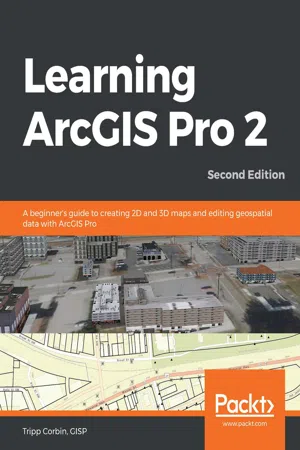
Learning ArcGIS Pro 2
A beginner's guide to creating 2D and 3D maps and editing geospatial data with ArcGIS Pro, 2nd Edition
- 542 pages
- English
- ePUB (mobile friendly)
- Available on iOS & Android
Learning ArcGIS Pro 2
A beginner's guide to creating 2D and 3D maps and editing geospatial data with ArcGIS Pro, 2nd Edition
About this book
Create 2D maps and 3D scenes, analyze GIS data, and share your results with the GIS community using the latest ArcGIS Pro 2 features
Key Features
- Get up to speed with the new ribbon-based user interface, projects, models, and common workflows in ArcGIS Pro 2
- Learn how to visualize, maintain, and analyze GIS data
- Automate analysis and processes with ModelBuilder and Python scripts
Book Description
Armed with powerful tools to visualize, maintain, and analyze data, ArcGIS Pro 2 is Esri's newest desktop geographic information system (GIS) application that uses the modern ribbon interface and a 64-bit processor to make using GIS faster and more efficient. This second edition of Learning ArcGIS Pro will show you how you can use this powerful desktop GIS application to create maps, perform spatial analysis, and maintain data.
The book begins by showing you how to install ArcGIS and listing the software and hardware prerequisites. You'll then understand the concept of named user licensing and learn how to navigate the new ribbon interface to leverage the power of ArcGIS Pro for managing geospatial data. Once you've got to grips with the new interface, you'll build your first GIS project and understand how to use the different project resources available. The book shows you how to create 2D and 3D maps by adding layers and setting and managing the symbology and labeling. You'll also discover how to use the analysis tool to visualize geospatial data. In later chapters, you'll be introduced to Arcade, the new lightweight expression language for ArcGIS, and then advance to creating complex labels using Arcade expressions. Finally, you'll use Python scripts to automate and standardize tasks and models in ArcGIS Pro.
By the end of this ArcGIS Pro book, you'll have developed the core skills needed for using ArcGIS Pro 2.x competently.
What you will learn
- Navigate the user interface to create maps, perform analysis, and manage data
- Display data based on discrete attribute values or range of values
- Label features on a GIS map based on one or more attributes using Arcade
- Create map books using the map series functionality
- Share ArcGIS Pro maps, projects, and data with other GIS community members
- Explore the most used geoprocessing tools for performing spatial analysis
- Create Tasks based on common workflows to standardize processes
- Automate processes using ModelBuilder and Python scripts
Who this book is for
If you want to learn ArcGIS Pro to create maps and, edit and analyze geospatial data, this ArcGIS book is for you. No knowledge of GIS fundamentals or experience with any GIS tool or ArcGIS software suite is required. Basic Windows skills, such as navigating and file management, are all you need.
Frequently asked questions
- Essential is ideal for learners and professionals who enjoy exploring a wide range of subjects. Access the Essential Library with 800,000+ trusted titles and best-sellers across business, personal growth, and the humanities. Includes unlimited reading time and Standard Read Aloud voice.
- Complete: Perfect for advanced learners and researchers needing full, unrestricted access. Unlock 1.4M+ books across hundreds of subjects, including academic and specialized titles. The Complete Plan also includes advanced features like Premium Read Aloud and Research Assistant.
Please note we cannot support devices running on iOS 13 and Android 7 or earlier. Learn more about using the app.
Information
- Chapter 1, Introducing ArcGIS Pro
- Chapter 2, Navigating the Ribbon Interface
- Checking requirements for installing ArcGIS Pro
- Downloading and installing ArcGIS Pro
- Managing and assigning ArcGIS Pro licenses
Technical requirements
- Internet access
- ArcGIS Pro 2.6—Basic or a higher license
- Sample data downloaded and installed for this book
Checking requirements for installing ArcGIS Pro
Understanding ArcGIS Pro minimum system requirements
Learning about OS requirements
- Windows 10 Home, Pro, and Enterprise
- Windows 8.1 Pro and Enterprise
- Windows Server 2019 Standard and Datacenter
- Windows Server 2016 Standard and Datacenter
- Windows Server 2012 R2 Standard and Datacenter
- Windows Server 2012 Standard and Datacenter
Table of contents
- Title Page
- Copyright and Credits
- Dedication
- About Packt
- Contributors
- Preface
- Section 1: Introducing and Navigating ArcGIS Pro
- Introducing ArcGIS Pro
- Navigating the Ribbon Interface
- Section 2: Visualizing, Maintaining, and Analyzing Data
- Creating 2D Maps
- Creating 3D Scenes
- Creating and Working with Projects
- Creating a Layout
- Creating Map Books Using Map Series
- Learning to Edit Spatial Data
- Learning about Editing Tabular Data
- Performing Analysis with Geoprocessing Tools
- Section 3: Sharing Data and Automating processes
- Creating and Using Tasks
- Automating Processes with ModelBuilder and Python
- Sharing Your Work with Others
- Using Arcade Expressions for Labeling and Symbology
- GIS glossary
- Other Books You May Enjoy